Introduction
It has felt like years since the original Oculus Rift Development Kit, or DK1, was released - but it was only March 2013 when the future of VR was unleashed upon the world. Between March 2013 and now, Oculus VR has shown off different iterations of the Rift, including the Crystal Cove prototype at CES 2015 in January, and then the Development Kit 2, or DK2, just after. The company announced it would be selling the DK2 in July, 2014.
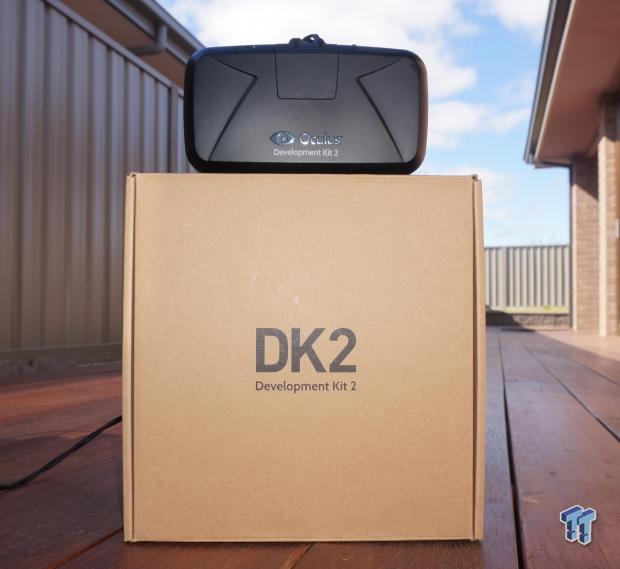
Oculus VR opened the doors up to the world for DK2 on March 19, seeing over 12,500 units pre-ordered in the first 36 hours. Days later, the company announced it was being acquired by Facebook for a huge $2 billion. This acquisition worried the world, including myself, but the team at Oculus were quick to react to the criticism. Fast forward to July, and Oculus begins shipping its first batch of DK2 to eager users. I missed the first batch, but made the second batch, receiving my unit on August 12 - but missed the postman, and didn't get my DK2 until two days later.
Oculus has been working closely with Samsung for a few months now, with Oculus receiving early access to Samsung's next-gen OLED panels. In return, Oculus provides early access to its mobile software development kit (SDK) to Samsung, with Samsung set to unveil its own VR device, Gear VR, in the coming weeks. This partnership with Samsung, which was most likely only made possible with the backing of Facebook, had allowed Oculus to bake in a considerably better panel into the DK2, which we're going to start talking about now.
Specifications, Pricing and Availability
The original Rift, at the time, was great - but its Achilles Heel was its display panel. DK1 was using a 7-inch 1280x800 LCD, similar, if not identical, to the one found in the Nexus 7 (2012 model) that was out at the time. This provided 640x800 per eye, with a 60Hz refresh rate, leaving users with a screen-door effect. This screen door effect was atrocious, but there was nothing else out at the time, so it was the only option. Still, DK1 was an impressive piece of kit, with the first device delivering a truly next-gen experience. Next-gen in the sense that it wasn't just a faster GPU, or console, but an entirely new device that provided a very unique experience - VR.
Oculus knew it had to up its game for DK2, with the company using a 5.7-inch 1920x1080 panel for its next-gen Rift. The 5.7-inch panel is ripped, quite literally, right out of the Galaxy Note 3 smartphone from Samsung. This means that the Rift DK2 unit uses a 5.7-inch 1920x1080 Super AMOLED display, which provides 960x1080 per eye, compared to just 640x800 per eye from the DK1. But it's not just resolution that helps the DK2 surpass the DK1.
What's In The Box
One of the first things that made the Oculus Rift unique at the time was the packaging that DK1 arrived in. The Rift DK1 arrived in a super-premium plastic case that made transporting, and keeping your Rift headset safe, something that was worth talking about. It was one of the surprise moments when opening up the outside box of the Rift, to find this premium plastic case inside. Well, unfortunately, there's no plastic case this time around - with a simple, but practical box for the DK2.
The box itself is great, but definitely no way near what the original DK1 unit came in. Oculus has wrapped everything individually, in perfectly packaged bags. Everything from the Rift headset itself, down to the B eyecups, all the way through to the positional tracking camera.
For those who don't want to watch the video, or want a quick list of what comes inside of the box, here's a list:
- Oculus Rift DK2 Headset (with detachable cable)
- Positional tracking camera
- 'B' lenses
- Positional tracker mini-USB to USB cable
- Positional tracker 3.5mm to 3.5mm sync cable
- DVI to HDMI adapter
- Power adapter (with 4 plugs: US, EU, UK, AU)
- Lens cleaning cloth
What's a list without some pictures?


The box that the DK2 comes in is plain, but it does the job.
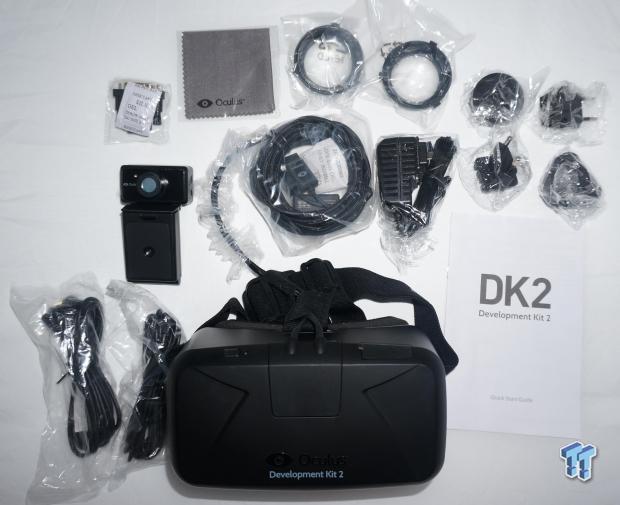
The DK2 box is filled with stuff, lots of VR stuff!
Pricing & Availability
When it comes to pricing, I really think what Oculus is offering with the Rift DK2 is an incredible price. I've read about the place that people don't recommend purchasing the Rift just yet, as it's just an 'expensive toy' or an 'expensive beta kit', but at $350 (without shipping), I think it represents great value. Even the DK1 was a fun time for over a year for $350, but the DK2 has much better technology, positional tracking, a low-persistence higher-resolution screen, and much more.
As for availability, you're going to be waiting quite some time to get it if you were to order it today. I would say that it would be at least the middle of October before people will get it, if they were to order when they read this review.
I used my everyday PC to run the Rift DK2, which also ensured that I constantly hit the 75FPS mark to meet the 75Hz refresh rate of the DK2's display. This meant that I didn't experience judder for most of my testing, but I did hit a few snags that I'll talk about in a follow up piece where I go deeper into the games and demos I'll be playing. For now, here's what I was running with the Rift DK2 headset:
- CPU: Intel Core i7 4930K processor w/Corsair H110i cooler
- Motherboard: ASUS Rampage IV Black Edition
- RAM: 16GB Corsair Vengeance Pro of 2400MHz DDR3
- GPU: NVIDIA GeForce GTX 780 SLI
- Storage: 240GB SanDisk Extreme II and 480GB SanDisk Extreme II
- Chassis: InWin X-Frame Limited Edition
- PSU: Corsair AX1200i digital PSU
- Software: Windows 7 Ultimate x64
Setup, Software & Hardware
Setup & Software
After taking everything out of the box, the setup process begins. Setting up the DK2 is a little more time consuming compared to the DK1, but the extra time spent is more than worth it. The additional time required is because there are multiple cables running all over the place, with a 3.5mm and separate USB cable running to the positional tracker, into the PC (USB) and into the DK2 (3.5mm). The Rift itself plugs into your PC through HDMI directly into your video card, and then into a spare USB port.
You'll also need to download the Oculus SDK from the Oculus Developer Center website, and then you can unleash your Internet connection to download countless games and demos that work with the Rift - with the DK2 backwards compatible (most of the time) with DK1 content.
Once you've got it all plugged together, turn the Rift DK2 on and away you go. The Oculus Configuration Utility will need some setting up, but if you've moved from the DK1, your settings will move across, which is a nice touch. In the OCU, you can adjust the Eye Relief settings, create a new User with new height settings, and you can also choose which eye cups you're using - for our testing, and my eyes, I'm using the default A eye cups.
After you've set the Oculus Configuration Utility to your personal needs, click the Show Demo Scene, where you'll be transported to a virtual desk - this is the first time you'll be able to experience the world of VR through the new Rift DK2. This will be the first time, for most people who test this, where they sit back and fully realize within seconds at the possibilities of VR. The demo is a good way to show off the positional tracking camera, as you can move closer to the desk in the demo, looking at the leaves on the little plant, or the house of cards. But this is just the beginning, and this is simply a demo scene.
Another new feature from the new SDK is that you can now render the game or demo that you're pumping into the Rift directly to the Rift itself. Normally, you'd have to have an extended desktop, which saw the Rift (DK1 or DK2) as a secondary monitor. It's not like this was a showstopper, but it made things a little more complicated. There are benefits of rendering directly to the Rift too, with reduced latency - resulting in a smoother VR experience.
Hardware
This is the biggest change with the DK2, the improved hardware and features. We talked about it quickly above, but now we're going to explain a little more about the things that make the DK2 tick, and what makes it world's beyond what the DK1 offered.
First and foremost, the increased resolution is the biggest improvement - moving from 1280x800 to 1920x1080 is a game changer for the DK2. But it's not just the increased resolution that is what is driving the massive improvement over the DK1 in Oculus' new VR headset. It is something that Valve pioneered, something that Oculus has baked into the DK2 after collaborating with the company: low-persistence of vision.
Low-persistence is something that allows the new Rift to reduce motion artifacts, as it only displays the latest, correct display information that is relative to the user's vision at the time. Where things blurred to oblivion in the DK1, the DK2 feels like it is refreshing at twice the 60Hz refresh rate of the DK1. An easy way to explain this difference is, it's like going from 60Hz panel, to a 120Hz panel - and for those who have never done that, then it would be like comparing the first LCD monitors to their CRT counterparts - the higher refresh rate always, always felt smoother. The DK2 is unbelievably smooth compared to the DK1.

So, we have the increased resolution, at 1920x1080, a low-persistence display, but there's something else that forms the glue of presence - making you feel, or at least tricking your brain, into thinking you're in the VR world. Oculus went with Samsung's Super AMOLED panel, which provides a high amount of contrast, but very, very deep blacks. The deep blacks are achieved by the DK2 because there is no backlight, or other light near your eyes, because your eyes are encased within the Rift headset. This allows the OLEDs to turn off, achieving close to true black. Colors on the DK2 panel are much more vivid and brighter on the DK2 when compared to the DK1, too.
Let's talk about the DK2 itself, which weighs more than the DK1, but this is something I couldn't tell the difference apart. If anything, the DK2 felt lighter in my hands, and I also felt no difference with the DK2 on my head in terms of weight. There's more room for my nose, which meant I wasn't fogging up the lens cups so easily, which is a nice change over the DK1. The DK2 weighs 440g (or 0.97 pounds) compared to the DK1 which weighs 380g (or 0.83 pounds).

On the front of the DK2 is a power button, something that the DK1 lacked - the power functionality was on the break out box for the DK1. To the right of the power button are the USB and HDMI cables, which are held together and under an elastic band. These two cables go over your head, instead of to the side, which helps with not getting tangled in cords like you would with the DK1.

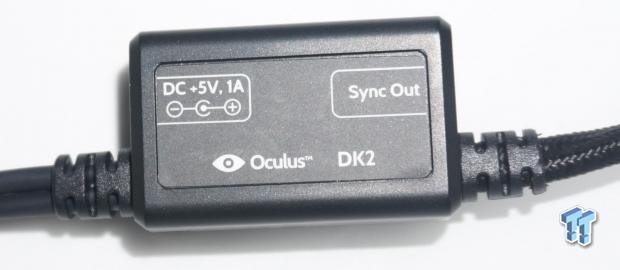
The little sync box in between the Rift and your PC (which plugs into both HDMI and USB) is much smaller than the breakout box on the DK1, as you can see in the shot above.

On the side of the DK2 we have the same adjustment that we had on the DK1, but the screws are a little bigger, making it easier to manage.




Here we have a couple of shots of the positional tracking camera.
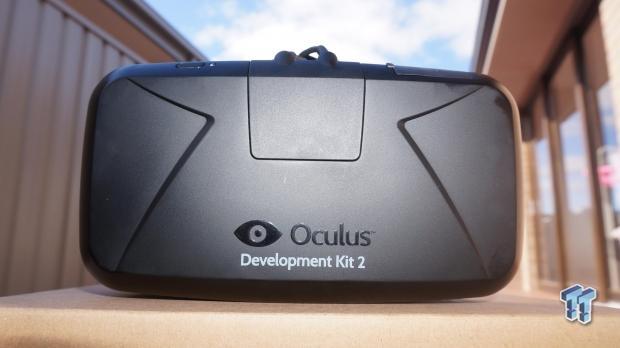
A front-on view of the Oculus Rift DK2.
First Impressions, What's Hot, What's Not & Final Thoughts
First Impressions
I haven't even had the DK2 in my possession for more than 24 hours, so this is nothing more than a first impressions piece. I've covered the hardware in detail, the set up process, but the actual gaming and demos I'll be testing over the next week or so with another article to come. But, my first impressions are nothing but good things so far, with just a few issues. First, let's talk about what I liked with the DK2 compared to the DK1.
Jumping into the demo scene that is found in the Oculus Configuration Utility brings you into the world of what the positional tracker provides - the ability to move within the VR space, instead of just being in the VR space. The ability to look at, and around objects, within the VR world is something that the DK2 does very well. Within those few seconds, I noticed the increased resolution and screen brightness, as well as the deep black levels.
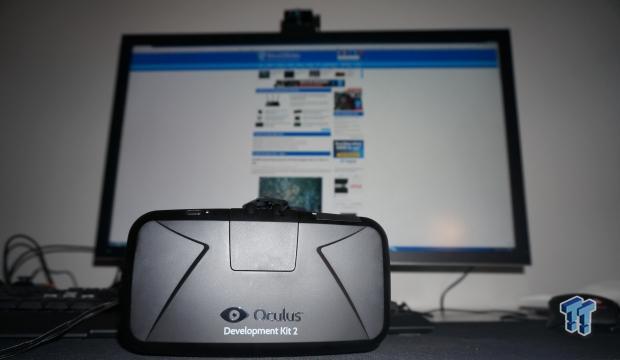
The increased resolution is something that VR needs going into the future, and is something I'm quite vocal about. I think we're going to see Oculus release the CV1 (Consumer Version 1, the first retail version of the Rift built for consumers) with a 1440p display, but it'll quickly ramp up in resolution with CV2 and beyond. Either we're going to see Oculus release the Rift in the first half of next year with a 1440p display, or they will wait it out for mobile 4K displays.
The 5.7-inch 1080p Super AMOLED panel brings the DK2 into an entire new world of possibilities, with some of the games and demos I tested being very night and day differences between the DK1 and DK2 thanks to the increased resolution and brightness. I was able to read text in everything I tested without a problem, something I could never do in the DK1 with its low resolution and screen door effect. Secondly, the low-persistence technology is simply amazing. It feels like the DK1 would be a 30Hz panel, and the DK2 is a 100Hz panel, it's really that smooth (if you have the hardware).
In some of the demos I played, I found myself saying things like "holy s**t" and "oh my god" out loud, a lot. I was really quite impressed with the increased resolution, color, low-persistence display, and sense of scale within DK2. I used 'Whirligig' which is a movie playback piece of software, watching Man of Steel. This player allows for the movie to be displayed on a curve (left to right) and zoomed in a little in general, providing an IMAX-like experience.
Near the end of the movie, Superman and Zod are fighting in Metropolis, where Superman is punched up 80 stories into the air, up the side of a building. Superman flies down, Zod jumps up the building and they smash into each other, with Superman flying up into another building to find Zod. Zod appears out of nowhere with a massive steel girder in his hands, and thanks to the IMAX-like screen size that the 1080p-capable DK2 provides, I physically looked up (kind of from Superman's perspective) at Zod, as he landed on the ground hitting Superman with the girder. It's these little experiences where you quietly say to yourself 'wow... just, wow'. VR really is going to change everything over the next decade.
What's Hot
Improved Display, in More Ways Than One: Oculus has improved the display on the DK2 over the DK1 in a number of ways, not just in the increased resolution, but the Super AMOLED-based panel makes a big difference, and so does the low-persistence technology found in the updated Rift.
DK2 is Better Quality, From Cables to Plastics: From the cables provided, the packaging (apart from there being a lack of an awesome plastic case for the Rift), the plastics used on the DK2 unit itself, Oculus has put some serious work on the DK2. It feels much more like a finished product, instead of something that was simply put together like the DK1 was. It feels like this is something you could buy off the shelf.
VR... Just... Wow.: If you've never tried out the Oculus Rift before, you haven't seen anything yet. The experience is simply indescribable. I could sit here and write another 3000 words on top of what I've already written, but it simply wouldn't do it justice. Oculus is onto something with the Rift, and if you thought the DK1 was good, the DK2 beats it in nearly every single sense.
What's Not
High PC Requirements: I'm running quite a high-end PC, which is something that isn't common. But, as Oculus' founder Palmer Luckey has said, this is the 'wild wild west' of VR. I feel this is the same thing I experienced back in the original Quake and Unreal days, where you would require an insane amount of expensive hardware to get the best out of the software. The DK2 requires a serious machine, but the results are more than worth it.
Final Thoughts
The DK2 is a huge improvement over the DK1 in more ways than one, but it's not perfect just yet. The increased resolution, positional tracking, higher quality materials used, the SDK and associated software is an improvement (and constantly getting better), and so much more. Oculus is making slow evolutions in the Rift and its software that is catapulting them toward the launch of the CV1 sometime in 2015.
I think we're going to get a near-perfect product when the Rift reaches 4K (or higher) at 100Hz (or higher) and one of the things that is going to make it a much better product is making the Rift wireless. Having a cord strapped to your head can get annoying, with most demos seeing you turn around and swing from side to side in your chair - a wireless VR headset would be a huge improvement over a VR headset tethered to your desk.
Most people say the Rift isn't worth the $350, but I say that it is. Why? Because people spend more on things like a new GPU, or a new monitor, and won't necessarily get more performance, or something better. If you're running a 1920x1080 60Hz monitor, why would you go for GeForce GTX Titan's or 780 Ti's in SLI? You're going to be maxing out virtually every game on the market at 60FPS, so you'll only be able to crank every visual detail up (AA, etc) to squeeze performance out of the GPU. It doesn't change the game, or add to it - it compliments it.
The Oculus Rift DK2 on the other hand changes everything. Not all games work with it, but I've found more amazement, more joy and excitement, from little 5-minute demos than I've found in games over the last decade. Virtual reality is going to change things, and it all starts with the Rift. If you invest $350 into the Rift, you will not be sorry - but just be prepared to have the hardware to run it at 75FPS, and that it isn't a final product - but still, it's a helluva fun time.


 United
States: Find other tech and computer products like this
over at
United
States: Find other tech and computer products like this
over at  United
Kingdom: Find other tech and computer products like this
over at
United
Kingdom: Find other tech and computer products like this
over at  Australia:
Find other tech and computer products like this over at
Australia:
Find other tech and computer products like this over at  Canada:
Find other tech and computer products like this over at
Canada:
Find other tech and computer products like this over at  Deutschland:
Finde andere Technik- und Computerprodukte wie dieses auf
Deutschland:
Finde andere Technik- und Computerprodukte wie dieses auf